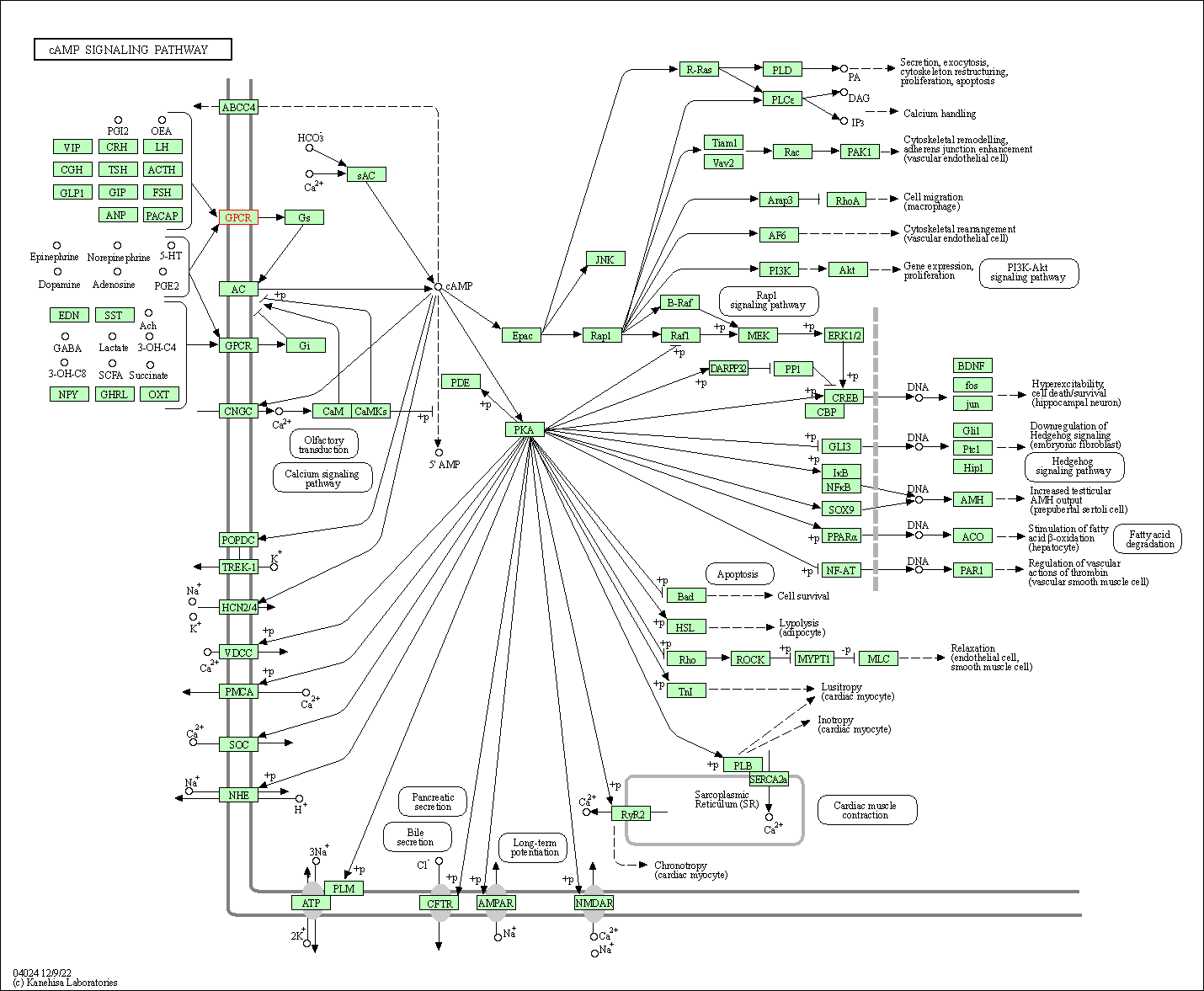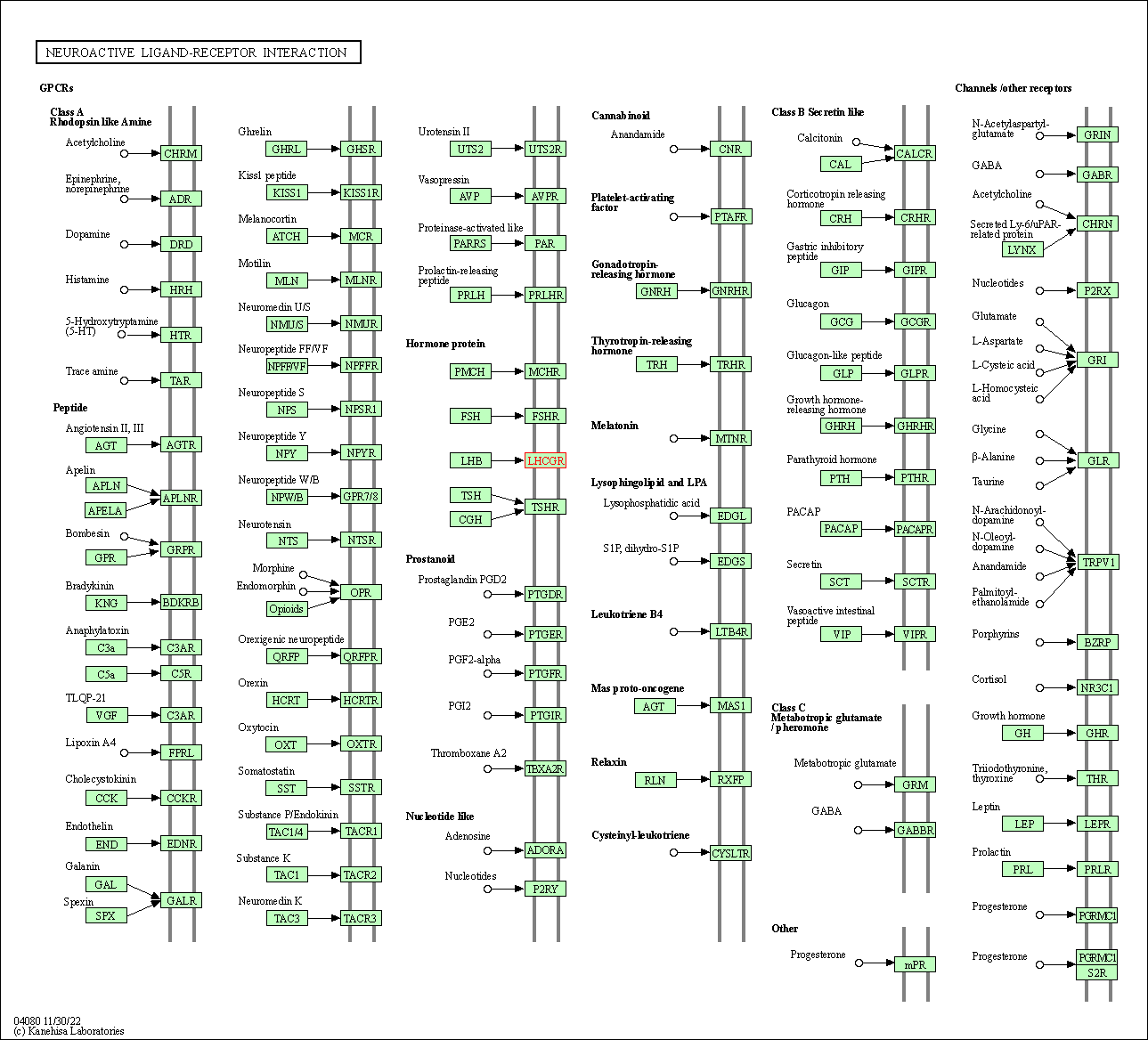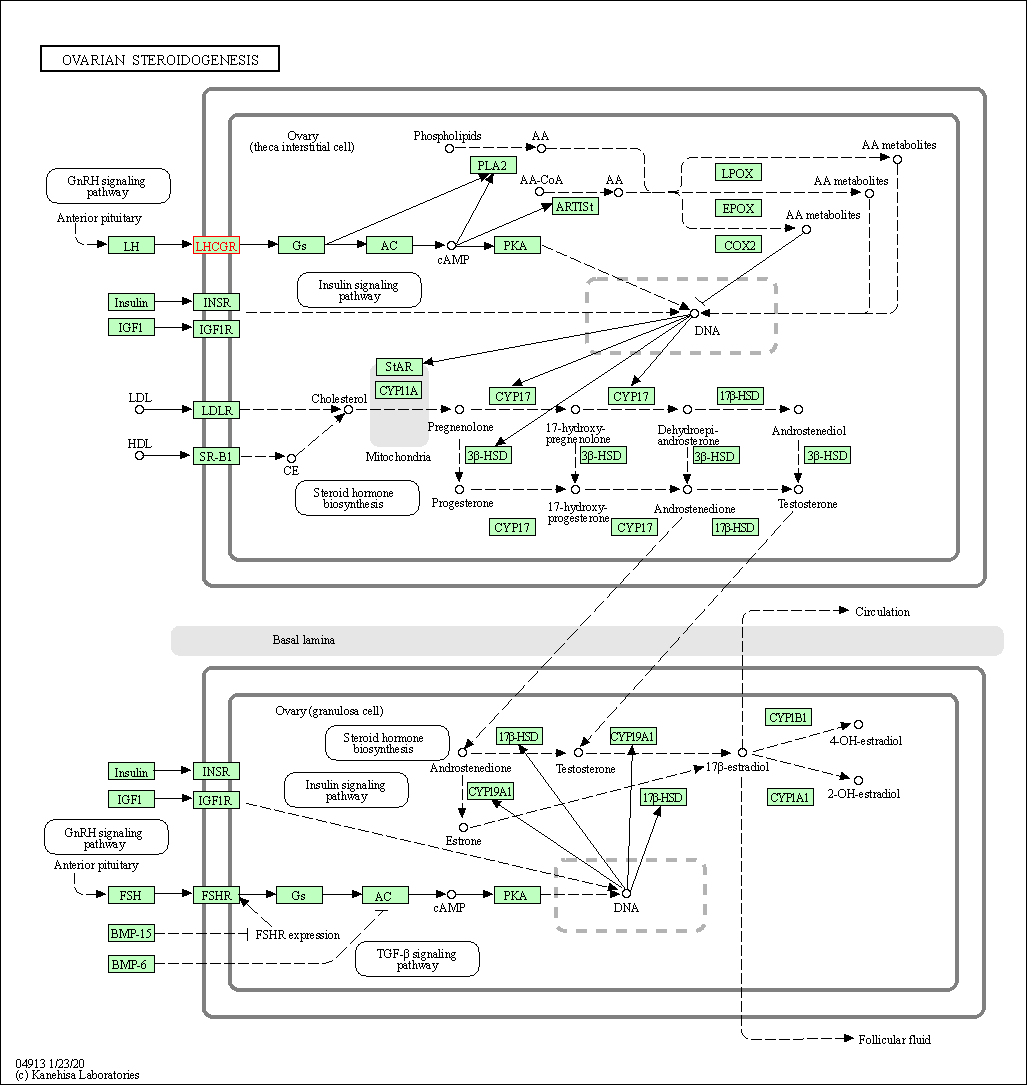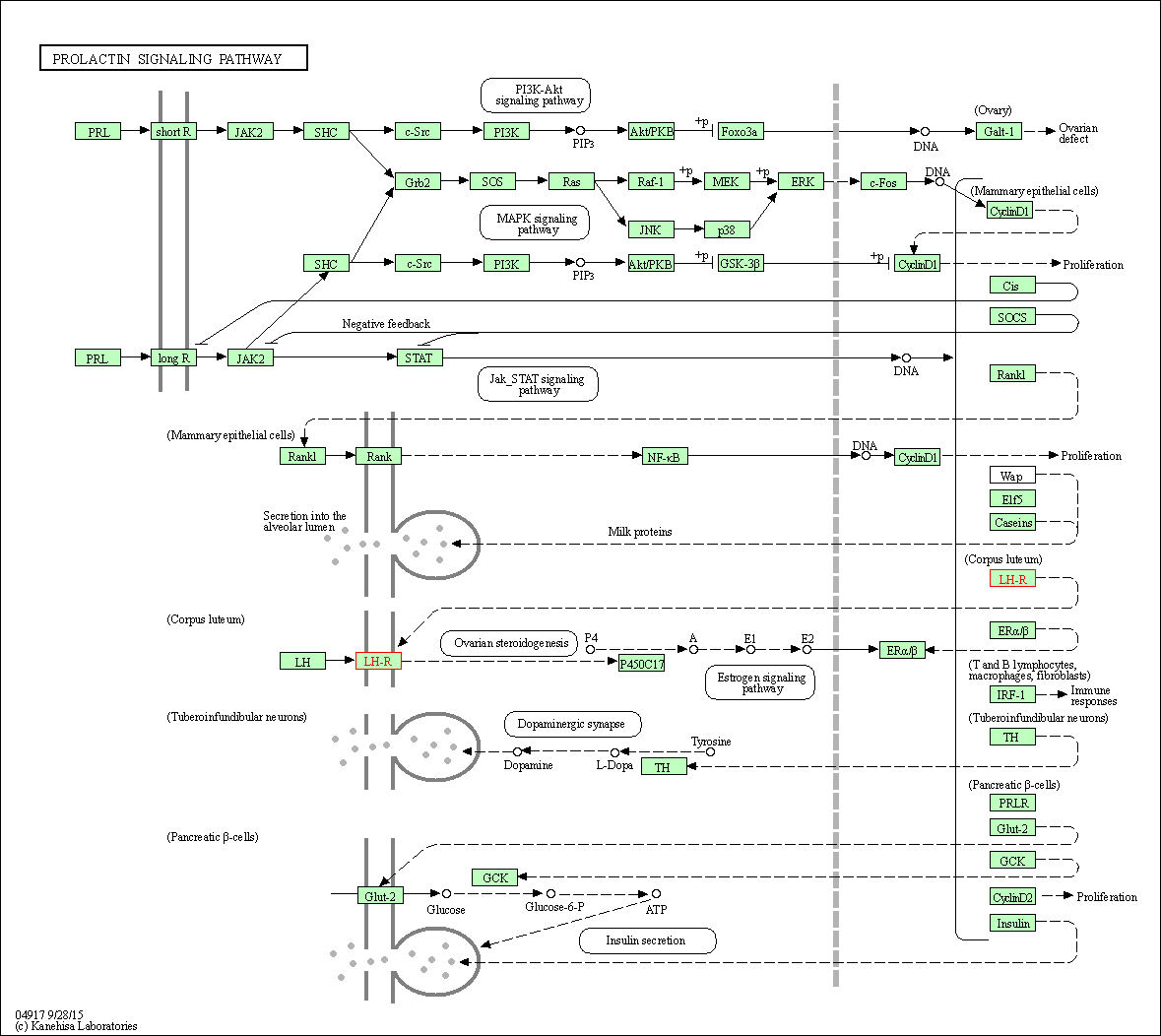Target Information
| Target General Information | Top | |||||
|---|---|---|---|---|---|---|
| Target ID |
T79473
(Former ID: TTDS00254)
|
|||||
| Target Name |
Luteinizing hormone receptor (LHCGR)
|
|||||
| Synonyms |
Luteinizing hormone-releasing hormone receptor; LSH-R; LHRH receptor; LHCGR; LH/CG-R
Click to Show/Hide
|
|||||
| Gene Name |
LHCGR
|
|||||
| Target Type |
Successful target
|
[1] | ||||
| Disease | [+] 2 Target-related Diseases | + | ||||
| 1 | Female infertility [ICD-11: GA31] | |||||
| 2 | Pituitary gland disorder [ICD-11: 5A60-5A61] | |||||
| Function |
Receptor for lutropin-choriogonadotropic hormone. The activity of this receptor is mediated by G proteins which activate adenylate cyclase.
Click to Show/Hide
|
|||||
| BioChemical Class |
GPCR rhodopsin
|
|||||
| UniProt ID | ||||||
| Sequence |
MKQRFSALQLLKLLLLLQPPLPRALREALCPEPCNCVPDGALRCPGPTAGLTRLSLAYLP
VKVIPSQAFRGLNEVIKIEISQIDSLERIEANAFDNLLNLSEILIQNTKNLRYIEPGAFI NLPRLKYLSICNTGIRKFPDVTKVFSSESNFILEICDNLHITTIPGNAFQGMNNESVTLK LYGNGFEEVQSHAFNGTTLTSLELKENVHLEKMHNGAFRGATGPKTLDISSTKLQALPSY GLESIQRLIATSSYSLKKLPSRETFVNLLEATLTYPSHCCAFRNLPTKEQNFSHSISENF SKQCESTVRKVNNKTLYSSMLAESELSGWDYEYGFCLPKTPRCAPEPDAFNPCEDIMGYD FLRVLIWLINILAIMGNMTVLFVLLTSRYKLTVPRFLMCNLSFADFCMGLYLLLIASVDS QTKGQYYNHAIDWQTGSGCSTAGFFTVFASELSVYTLTVITLERWHTITYAIHLDQKLRL RHAILIMLGGWLFSSLIAMLPLVGVSNYMKVSICFPMDVETTLSQVYILTILILNVVAFF IICACYIKIYFAVRNPELMATNKDTKIAKKMAILIFTDFTCMAPISFFAISAAFKVPLIT VTNSKVLLVLFYPINSCANPFLYAIFTKTFQRDFFLLLSKFGCCKRRAELYRRKDFSAYT SNCKNGFTGSNKPSQSTLKLSTLHCQGTALLDKTRYTEC Click to Show/Hide
|
|||||
| 3D Structure | Click to Show 3D Structure of This Target | AlphaFold | ||||
| ADReCS ID | BADD_A00575 | |||||
| Drugs and Modes of Action | Top | |||||
|---|---|---|---|---|---|---|
| Approved Drug(s) | [+] 3 Approved Drugs | + | ||||
| 1 | Choriogonadotropin alfa | Drug Info | Approved | Female infertility | [2] | |
| 2 | Chorionic Gonadotropin | Drug Info | Approved | Fertility problem | [3] | |
| 3 | Lutropin alfa | Drug Info | Approved | Female infertility | [2] | |
| Clinical Trial Drug(s) | [+] 2 Clinical Trial Drugs | + | ||||
| 1 | ML-04 | Drug Info | Phase 2 | Myelodysplastic syndrome | [4] | |
| 2 | Org-43902 | Drug Info | Phase 1 | Infertility | [5] | |
| Discontinued Drug(s) | [+] 2 Discontinued Drugs | + | ||||
| 1 | LDI-200 | Drug Info | Discontinued in Phase 3 | leukaemia | [6] | |
| 2 | Human chorionic gonadotropin | Drug Info | Terminated | Heart disease | [7], [8] | |
| Mode of Action | [+] 4 Modes of Action | + | ||||
| Modulator | [+] 5 Modulator drugs | + | ||||
| 1 | Choriogonadotropin alfa | Drug Info | [9] | |||
| 2 | Chorionic Gonadotropin | Drug Info | [9] | |||
| 3 | ML-04 | Drug Info | [10] | |||
| 4 | LDI-200 | Drug Info | [12] | |||
| 5 | EP-200 | Drug Info | [12] | |||
| Binder | [+] 1 Binder drugs | + | ||||
| 1 | Lutropin alfa | Drug Info | [1] | |||
| Agonist | [+] 1 Agonist drugs | + | ||||
| 1 | Org-43902 | Drug Info | [11] | |||
| Inhibitor | [+] 1 Inhibitor drugs | + | ||||
| 1 | Human chorionic gonadotropin | Drug Info | [12] | |||
| Cell-based Target Expression Variations | Top | |||||
|---|---|---|---|---|---|---|
| Cell-based Target Expression Variations | ||||||
| Drug Binding Sites of Target | Top | |||||
|---|---|---|---|---|---|---|
| Ligand Name: CID 9914457 | Ligand Info | |||||
| Structure Description | luteinizing hormone/choriogonadotropin receptor(S277I)-chorionic gonadotropin-Gs-Org43553 complex | PDB:7FIH | ||||
| Method | Electron microscopy | Resolution | 3.20 Å | Mutation | Yes | [13] |
| PDB Sequence |
TRLSLAYLPV
61 KVIPSQAFRG71 LNEVIKIEIS81 QIDSLERIEA91 NAFDNLLNLS101 EILIQNTKNL 111 RYIEPGAFIN121 LPRLKYLSIC131 NTGIRKFPDV141 TKVFSSESNF151 ILEICDNLHI 161 TTIPGNAFQG171 MNNESVTLKL181 YGNGFEEVQS191 HAFNGTTLTS201 LELKENVHLE 211 KMHNGAFRGA221 TGPKTLDISS231 TKLQALPSYG241 LESIQRLIAT251 SSYSLKKLPS 261 RETFVNLLEA271 TLTYPIHCCA281 FRNLPDYEYG334 FCLPKTPRCA344 PEPDAFNPCE 354 DIMGYDFLRV364 LIWLINILAI374 MGNMTVLFVL384 LTSRYKLTVP394 RFLMCNLSFA 404 DFCMGLYLLL414 IASVDSQTKG424 QYYNHAIDWQ434 TGSGCSTAGF444 FTVFASELSV 454 YTLTVITLER464 WHTITYAIHL474 DQKLRLRHAI484 LIMLGGWLFS494 SLIAMLPLVG 504 VSNYMKVSIC514 FPMDVETTLS524 QVYILTILIL534 NVVAFFIICA544 CYIKIYFAVR 554 NPELMATNKD564 TKIAKKMAIL574 IFTDFTCMAP584 ISFFAISAAF594 KVPLITVTNS 604 KVLLVLFYPI614 NSCANPFLYA624 IFTKTFQRDF634 FLLLSKFGCC644 |
|||||
|
|
ALA349
4.194
PHE350
3.344
THR446
4.519
VAL447
3.960
SER450
4.066
GLU451
3.534
PHE515
3.209
PRO516
3.374
MET517
3.490
VAL519
3.413
ILE528
3.667
ILE531
3.520
LEU532
4.732
ASN535
4.404
|
|||||
| Click to View More Binding Site Information of This Target with Different Ligands | ||||||
| Different Human System Profiles of Target | Top |
|---|---|
|
Human Similarity Proteins
of target is determined by comparing the sequence similarity of all human proteins with the target based on BLAST. The similarity proteins for a target are defined as the proteins with E-value < 0.005 and outside the protein families of the target.
A target that has fewer human similarity proteins outside its family is commonly regarded to possess a greater capacity to avoid undesired interactions and thus increase the possibility of finding successful drugs
(Brief Bioinform, 21: 649-662, 2020).
Human Pathway Affiliation
of target is determined by the life-essential pathways provided on KEGG database. The target-affiliated pathways were defined based on the following two criteria (a) the pathways of the studied target should be life-essential for both healthy individuals and patients, and (b) the studied target should occupy an upstream position in the pathways and therefore had the ability to regulate biological function.
Targets involved in a fewer pathways have greater likelihood to be successfully developed, while those associated with more human pathways increase the chance of undesirable interferences with other human processes
(Pharmacol Rev, 58: 259-279, 2006).
Human Similarity Proteins
Human Pathway Affiliation
|
|
| KEGG Pathway | Pathway ID | Affiliated Target | Pathway Map |
|---|---|---|---|
| Calcium signaling pathway | hsa04020 | Affiliated Target |

|
| Class: Environmental Information Processing => Signal transduction | Pathway Hierarchy | ||
| cAMP signaling pathway | hsa04024 | Affiliated Target |

|
| Class: Environmental Information Processing => Signal transduction | Pathway Hierarchy | ||
| Neuroactive ligand-receptor interaction | hsa04080 | Affiliated Target |

|
| Class: Environmental Information Processing => Signaling molecules and interaction | Pathway Hierarchy | ||
| Ovarian steroidogenesis | hsa04913 | Affiliated Target |

|
| Class: Organismal Systems => Endocrine system | Pathway Hierarchy | ||
| Prolactin signaling pathway | hsa04917 | Affiliated Target |

|
| Class: Organismal Systems => Endocrine system | Pathway Hierarchy | ||
| Chemical Structure based Activity Landscape of Target | Top |
|---|---|
| Co-Targets | Top | |||||
|---|---|---|---|---|---|---|
| Co-Targets | ||||||
| Target Poor or Non Binders | Top | |||||
|---|---|---|---|---|---|---|
| Target Poor or Non Binders | ||||||
| Target Profiles in Patients | Top | |||||
|---|---|---|---|---|---|---|
| Target Expression Profile (TEP) | ||||||
| Target Affiliated Biological Pathways | Top | |||||
|---|---|---|---|---|---|---|
| KEGG Pathway | [+] 4 KEGG Pathways | + | ||||
| 1 | Calcium signaling pathway | |||||
| 2 | Neuroactive ligand-receptor interaction | |||||
| 3 | Ovarian steroidogenesis | |||||
| 4 | Prolactin signaling pathway | |||||
| NetPath Pathway | [+] 1 NetPath Pathways | + | ||||
| 1 | FSH Signaling Pathway | |||||
| Pathwhiz Pathway | [+] 1 Pathwhiz Pathways | + | ||||
| 1 | Intracellular Signalling Through LHCGR Receptor and Luteinizing Hormone/Choriogonadotropin | |||||
| PID Pathway | [+] 1 PID Pathways | + | ||||
| 1 | Arf6 signaling events | |||||
| Reactome | [+] 2 Reactome Pathways | + | ||||
| 1 | Hormone ligand-binding receptors | |||||
| 2 | G alpha (s) signalling events | |||||
| WikiPathways | [+] 5 WikiPathways | + | ||||
| 1 | GPCRs, Class A Rhodopsin-like | |||||
| 2 | Ovarian Infertility Genes | |||||
| 3 | Peptide GPCRs | |||||
| 4 | GPCR ligand binding | |||||
| 5 | GPCR downstream signaling | |||||
| References | Top | |||||
|---|---|---|---|---|---|---|
| REF 1 | Lutropin alfa. Drugs. 2008;68(11):1529-40. | |||||
| REF 2 | Natural products as sources of new drugs over the last 25 years. J Nat Prod. 2007 Mar;70(3):461-77. | |||||
| REF 3 | Drugs@FDA. U.S. Food and Drug Administration. U.S. Department of Health & Human Services. 2015 | |||||
| REF 4 | ClinicalTrials.gov (NCT00044226) A 20-Week Study of a New Treatment for Men With Benign Prostatic Hyperplasia (BPH).. U.S. National Institutes of Health. | |||||
| REF 5 | Trusted, scientifically sound profiles of drug programs, clinical trials, safety reports, and company deals, written by scientists. Springer. 2015. Adis Insight (drug id 800042073) | |||||
| REF 6 | Trusted, scientifically sound profiles of drug programs, clinical trials, safety reports, and company deals, written by scientists. Springer. 2015. Adis Insight (drug id 800006739) | |||||
| REF 7 | URL: http://www.guidetopharmacology.org Nucleic Acids Res. 2015 Oct 12. pii: gkv1037. The IUPHAR/BPS Guide to PHARMACOLOGY in 2016: towards curated quantitative interactions between 1300 protein targets and 6000 ligands. (Ligand id: 1160). | |||||
| REF 8 | Trusted, scientifically sound profiles of drug programs, clinical trials, safety reports, and company deals, written by scientists. Springer. 2015. Adis Insight (drug id 800009926) | |||||
| REF 9 | Drugs@FDA. U.S. Food and Drug Administration. U.S. Department of Health & Human Services. | |||||
| REF 10 | Evaluation of radiolabeled ML04, a putative irreversible inhibitor of epidermal growth factor receptor, as a bioprobe for PET imaging of EGFR-overexpressing tumors. Nucl Med Biol. 2007 Jan;34(1):55-70. | |||||
| REF 11 | First evidence of ovulation induced by oral LH agonists in healthy female volunteers of reproductive age. J Clin Endocrinol Metab. 2013 Apr;98(4):1558-66. | |||||
| REF 12 | URL: http://www.guidetopharmacology.org Nucleic Acids Res. 2015 Oct 12. pii: gkv1037. The IUPHAR/BPS Guide to PHARMACOLOGY in 2016: towards curated quantitative interactions between 1300 protein targets and 6000 ligands. (Target id: 254). | |||||
| REF 13 | Structures of full-length glycoprotein hormone receptor signalling complexes. Nature. 2021 Oct;598(7882):688-692. | |||||
If You Find Any Error in Data or Bug in Web Service, Please Kindly Report It to Dr. Zhou and Dr. Zhang.

